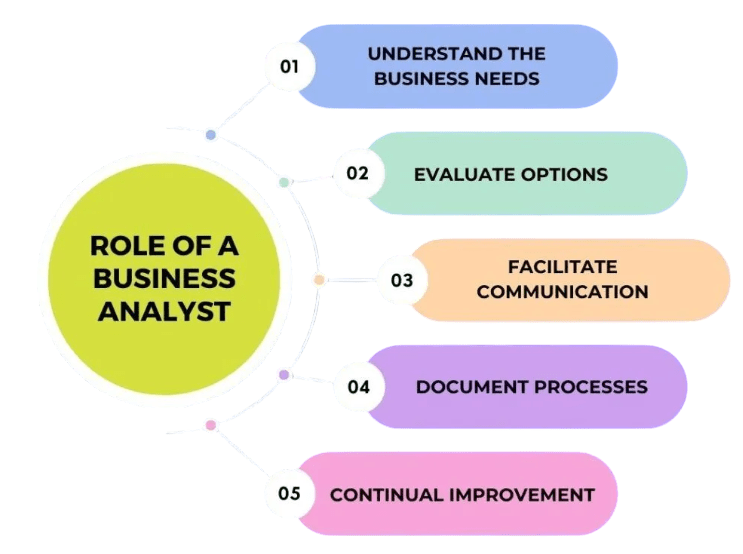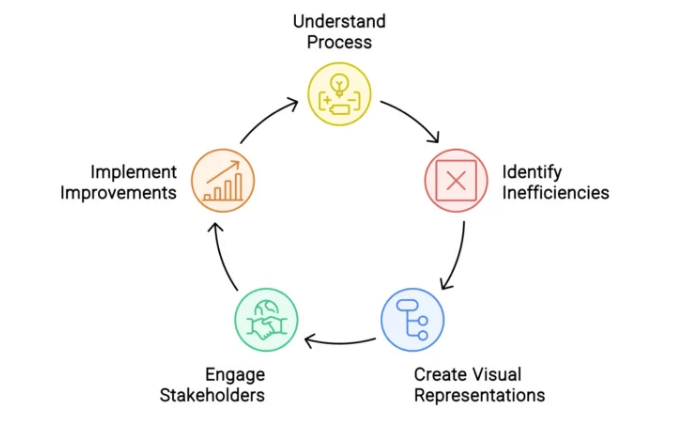
- Introduction to the Business Analyst Role
- Responsibilities and Deliverables
- Requirement Gathering Techniques
- Business Process Modeling
- Working with Stakeholders
- Creating User Stories and Use Cases
- Functional and Non-Functional Requirements
- Tools Used by Business Analysts
Introduction to the Business Analyst Role
A Business Analyst is a professional who plays a crucial role in helping organizations enhance their processes, products, services, and software systems. This is achieved through a combination of data analysis, requirement gathering, stakeholder communication, and solution assessment. The primary focus of a Business Analyst is to understand business challenges and opportunities, elicit and document clear requirements, and ensure that the outcomes of projects are aligned with organizational goals. By acting as a bridge between business stakeholders and technical teams, Business Analysts ensure that the solutions developed are not only technically sound but also meet the actual needs of the business. Business Analysts collaborate with a wide range of stakeholders across various departments such as marketing, operations, finance, information technology, and even external clients or vendors through effective Business Analyst Training. This cross-functional engagement allows them to gather input from multiple perspectives, leading to more comprehensive and practical solutions. Their responsibilities often include conducting stakeholder interviews, analyzing business processes, writing functional and non-functional requirements, creating user stories or use cases, and validating whether delivered solutions solve the intended problems. The versatility of the Business Analyst role makes it applicable across multiple industries. Whether in finance, healthcare, information technology, manufacturing, or government, organizations rely on Business Analysts to improve efficiency, reduce costs, and support digital transformation initiatives. By identifying gaps, recommending changes, and aligning solutions with strategic objectives, Business Analysts contribute significantly to project success and long-term business performance. Their unique blend of analytical thinking, communication skills, and domain knowledge makes them an essential asset in modern organizations seeking to remain competitive and agile in a rapidly changing environment.
Interested in Obtaining Your Business Analyst Certificate? View The Business Analyst Training Offered By ACTE Right Now!
Responsibilities and Deliverables
A Business Analyst performs several critical functions throughout the project lifecycle to ensure that business needs are accurately identified and effectively addressed. One of the foundational tasks is requirement elicitation, which involves gathering information from stakeholders to understand the underlying needs and expectations of the business. This step is followed by requirement analysis, where the gathered information is examined for clarity, feasibility, and alignment with organizational goals. The analysis ensures that requirements are actionable and relevant to the business context. Clear and structured documentation is another key responsibility of What Is Corporate Social Responsibility CSR. Business Analysts create essential documents such as Business Requirement Documents, which outline the business needs and project scope, and Functional Requirement Documents, which detail how the system should behave to fulfill those needs. They also develop use cases and user stories to describe specific user interactions with the system. Stakeholder management plays a central role, as Business Analysts engage with team members across departments to manage expectations, resolve conflicts, and maintain alignment throughout the project. Process modeling is used to visually map and analyze current workflows, helping identify areas for improvement or automation. As solutions are proposed, Business Analysts conduct solution assessments to ensure that each option meets the defined business requirements. They also support testing activities by helping create test cases and participating in validation efforts to confirm that the delivered solution addresses the intended needs.

Change management is another responsibility, where the Business Analyst helps prepare the organization for new processes or systems through communication and training. Supporting these efforts are deliverables like the Requirement Traceability Matrix, which links requirements to corresponding development and testing tasks, and validation plans that guide quality assurance. Together, these responsibilities ensure successful project delivery and long-term business value.
Requirement Gathering Techniques
- Importance of Requirement Gathering: Requirement gathering is a vital initial step that lays the groundwork for project success by clearly defining what needs to be built.
- Role of Business Analysts (BAs): BAs facilitate this process by engaging with stakeholders to collect, analyze, and document requirements accurately.
- Variety of Techniques: BAs use multiple techniques for requirement elicitation, choosing methods based on the project context, complexity, and stakeholder availability.
- Interviews and Workshops: Direct discussions like interviews and collaborative workshops help gather detailed information and clarify expectations, highlighting What Is the Importance Of Financial Analysis.
- Creating Mock-ups and Wireframes: Visual tools such as mock-ups or wireframes allow stakeholders to better understand proposed features, enabling more effective feedback and refinement of requirements.
- Advantages and Limitations: Each technique has its strengths and weaknesses; for example, interviews provide depth but may miss broader context, while mock-ups enhance visualization but require extra effort to create.
- Combining Techniques: Often, BAs combine several methods to ensure comprehensive requirement gathering, balancing clarity, completeness, and stakeholder engagement for optimal project outcomes.
- Importance of BPM in BA Role: Understanding and improving business processes is crucial for Business Analysts to help organizations optimize workflows and achieve efficiency.
- Flowcharts: These are simple diagrams that depict the sequence of activities and decision points, providing a clear, easy-to-understand overview of a process, which is a key skill taught in Business Analyst Training.
- Business Process Model and Notation (BPMN): BPMN is a standardized, detailed notation used to create comprehensive process diagrams that include events, tasks, gateways, and flows, offering precise modeling.
- Use Case Diagrams: These visualize the interactions between users (actors) and the system, clarifying functional requirements and user roles within processes.
- Swimlane Diagrams: Swimlane diagrams categorize process steps by departments or roles, highlighting responsibilities and handoffs to improve accountability and coordination.
- Value Stream Mapping: This technique identifies value-added versus non-value-added activities in a process, helping teams spot inefficiencies and eliminate waste to enhance productivity.
- Benefits of BPM: By modeling processes, BAs and stakeholders gain clarity on how work is performed, identify bottlenecks, redundancies, and uncover opportunities for automation or reengineering to streamline operations.
- User Stories Defined: User stories are brief, simple descriptions of a feature from the user’s perspective, capturing what they want and why.
- Agile Usage: User stories are widely used in Agile methodologies to gather requirements incrementally and flexibly, supporting iterative development.
- Use Cases Defined: Use cases provide more detailed and formal descriptions of interactions between users (actors) and the system to achieve specific goals, ensuring clarity, especially in the context of What is Insights-as-a-Service IaaS.
- Components of Use Cases: Use cases typically include the actors involved, preconditions for starting, the main flow (step-by-step interactions), alternative flows (exceptions or variations), and postconditions (expected outcomes).
- Purpose of Use Cases: They help developers and testers understand functional requirements thoroughly, enabling accurate design, coding, and testing of features.
- Communication Benefits: Both user stories and use cases facilitate clear communication among stakeholders, developers, and testers, reducing misunderstandings and aligning expectations.
- Ensuring User-Centered Solutions: By focusing on user needs and system interactions, these tools ensure that the final solution delivers real value and meets user requirements effectively.
To Earn Your Business Analyst Certification, Gain Insights From Leading Data Science Experts And Advance Your Career With ACTE’s Business Analyst Training Today!
Business Process Modeling

Working with Stakeholders
Effective stakeholder management is a core responsibility for Business Analysts, as stakeholders play a central role in the success of any project. Stakeholders include individuals or groups who are affected by or have influence over the outcome of a project. These may include business users, managers, developers, testers, vendors, and in some cases, even customers. Managing their interests, expectations, and concerns is essential to ensure that the final solution aligns with business objectives and user needs. The first step in stakeholder management is identifying who the stakeholders are. Business Analysts often use stakeholder analysis techniques to assess each stakeholder’s level of influence, interest, and specific communication needs. This helps in prioritizing engagement strategies and tailoring interactions accordingly. Building strong relationships with stakeholders is key in What Is SAP Human Capital Management HCM. This involves establishing trust and rapport through active listening, empathy, and consistent communication. When stakeholders feel heard and respected, they are more likely to engage constructively throughout the project. Managing expectations is equally important. Business Analysts must set clear, realistic goals and keep stakeholders informed of project progress, changes in scope, and potential risks. This transparency fosters alignment and reduces misunderstandings. Facilitating communication between technical teams and business users is another critical function. Business Analysts serve as the bridge, translating business needs into technical terms and helping non-technical stakeholders understand system limitations or technical solutions. In cases of disagreement, Business Analysts are often responsible for resolving conflicts by negotiating compromises and guiding the team toward shared objectives. By understanding stakeholder priorities and motivations, Business Analysts ensure that the requirements they gather and define truly reflect the needs of the business, leading to more successful project outcomes and stronger organizational support.
Want to Pursue a Business Analyst Master’s Degree? Enroll For Business Analyst Master Program Training Course Today!
Creating User Stories and Use Cases
Functional and Non-Functional Requirements
In business analysis and system design, it is essential to distinguish between functional and non-functional requirements, as both contribute to the overall success of a project. Functional requirements describe what the system should do. These are specific features, behaviors, or operations that a system must support to meet business needs. Examples of functional requirements include allowing users to log in and authenticate securely, generating various types of reports, processing transactions such as payments or order submissions, and validating data input to prevent errors or inconsistencies. These functions directly support day-to-day business activities and define the system’s primary capabilities. On the other hand, non-functional requirements describe how the system should perform. These requirements focus on quality attributes and system constraints rather than specific functionalities, highlighting key differences in Data Mining Vs Statistics. Examples of non-functional requirements include performance standards such as fast response times and minimal downtime, security protocols that protect sensitive data, and usability features that ensure the system is accessible to a wide range of users. Other important aspects include scalability, which ensures the system can handle increased load as the business grows, and availability, which refers to system uptime and reliability. Compliance with legal and industry regulations is also a critical non-functional requirement, particularly in sectors such as finance and healthcare. Both types of requirements are crucial. While functional requirements ensure that the system performs the necessary tasks, non-functional requirements often influence architectural and design decisions that impact the system’s long-term sustainability, user satisfaction, and risk management. Business Analysts must ensure that both categories are clearly defined, documented, and validated to create a complete and successful solution that meets the business objectives and user expectations.
Go Through These Business Analyst Interview Questions and Answers to Excel in Your Upcoming Interview.
Tools Used by Business Analysts
Business Analysts rely on a wide range of tools to effectively perform their roles, covering documentation, modeling, requirement management, communication, and prototyping. These tools help streamline processes, improve collaboration, and ensure that requirements are captured and communicated clearly. For documentation, Business Analysts often use Microsoft Word and Google Docs to create and share detailed requirement documents. Confluence is another widely used platform, offering a centralized knowledge base that supports version control and collaboration across teams. Modeling tools are essential for visualizing processes and system flows. Microsoft Visio is frequently used to create flowcharts and process maps. For web-based diagramming, Lucidchart and Draw.io are popular choices. Business Analysts working on more complex projects may use Enterprise Architect, a powerful tool that supports Unified Modeling Language and Business Process Model and Notation standards, as part of their Business Analyst Training. When it comes to managing requirements, tools like Jira are commonly used in Agile environments to manage backlogs, user stories, and sprints. For large-scale or highly regulated projects, IBM Rational DOORS provides robust capabilities for complex requirement tracking and traceability. Lighter tools such as Trello and Asana are often employed for task management and tracking smaller sets of requirements. Effective communication is crucial for stakeholder engagement. Microsoft Teams and Slack enable real-time messaging, file sharing, and video meetings. In addition, email and video conferencing tools help ensure consistent communication across distributed teams. Prototyping tools support the visualization of proposed solutions before development begins. Balsamiq, Figma, and Axure are widely used by Business Analysts to create wireframes, interactive mockups, and early-stage prototypes that clarify requirements and gather feedback from stakeholders. Together, these tools empower Business Analysts to deliver accurate, collaborative, and efficient business solutions.




